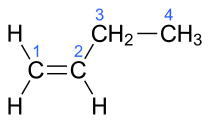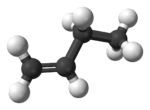1-Butene
 | |||
| |||
| Names | |||
|---|---|---|---|
| Preferred IUPAC name
But-1-ene[1] | |||
| Other names
Ethylethylene 1-Butylene α-Butylene | |||
| Identifiers | |||
| 3D model (JSmol) |
|||
| ChEBI | |||
| ChemSpider | |||
| ECHA InfoCard | 100.003.137 | ||
| PubChem CID |
|||
| UNII | |||
| |||
| |||
| Properties | |||
| C4H8 | |||
| Molar mass | 56.11 g·mol−1 | ||
| Appearance | Colorless Gas | ||
| Odor | slightly aromatic | ||
| Density | 0.62 g/cm3 | ||
| Melting point | −185.3 °C (−301.5 °F; 87.8 K) | ||
| Boiling point | −6.47 °C (20.35 °F; 266.68 K) | ||
| 0.221 g/100 mL | |||
| Solubility | soluble in alcohol, ether, benzene | ||
| Refractive index (nD) |
1.3962 | ||
| Viscosity | 7.76 Pa | ||
| Hazards | |||
| NFPA 704 | |||
| 385 °C (725 °F; 658 K) | |||
| Explosive limits | 1.6-10% | ||
| Except where otherwise noted, data are given for materials in their standard state (at 25 °C [77 °F], 100 kPa). | |||
| | |||
| Infobox references | |||
1-Butene is an organic chemical compound, linear alpha-olefin (alkene),[2] and one of the isomers of butene. The formula is CH3CH2CH=CH2. It is a highly flammable, easily condensed gas.
Reactions
1-Butene is stable in itself but polymerizes readily to polybutene. Its main application is as a comonomer in the production of certain kinds of polyethylene, such as linear low-density polyethylene (LLDPE). It has also been used as a precursor to polypropylene resins, butylene oxide, and butanone.[3]
Manufacturing
1-Butene is produced either by separation from crude C4 refinery streams or from the dimerization of ethylene. It is distilled to give a very high-purity product. An estimated 12 billion kilograms were produced in 2011, usually as a mixture with isomeric butenes.[4]
See also
References
- ↑ Nomenclature of Organic Chemistry : IUPAC Recommendations and Preferred Names 2013 (Blue Book). Cambridge: The Royal Society of Chemistry. 2014. pp. 17, 61, 374. ISBN 978-0-85404-182-4. doi:10.1039/9781849733069-FP001.
- ↑ 1-BUTENE
- ↑ 1-Butene product overview
- ↑ Frank M.A. Geilen, Guido Stochniol, Stephan Peitz and Ekkehard Schulte-Koerne "Butenes" in Ullmann's Encyclopedia of Industrial Chemistry, Wiley-VCH, Weinheim, 2014. doi:10.1002/14356007.a04_483.pub3








